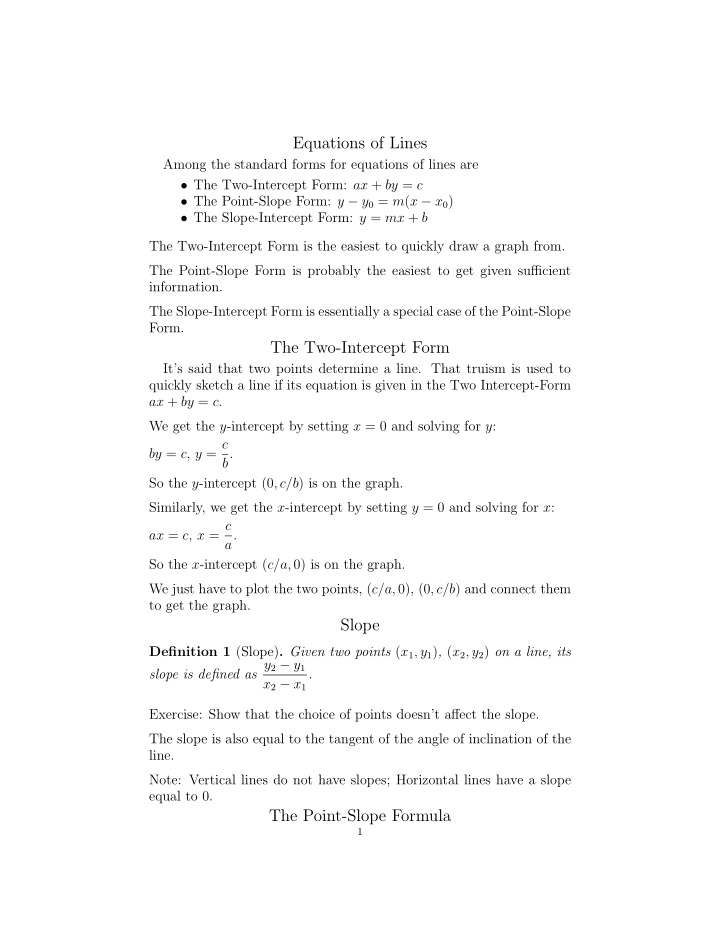



Equations of Lines Among the standard forms for equations of lines are • The Two-Intercept Form: ax + by = c • The Point-Slope Form: y − y 0 = m ( x − x 0 ) • The Slope-Intercept Form: y = mx + b The Two-Intercept Form is the easiest to quickly draw a graph from. The Point-Slope Form is probably the easiest to get given sufficient information. The Slope-Intercept Form is essentially a special case of the Point-Slope Form. The Two-Intercept Form It’s said that two points determine a line. That truism is used to quickly sketch a line if its equation is given in the Two Intercept-Form ax + by = c . We get the y -intercept by setting x = 0 and solving for y : by = c , y = c b . So the y -intercept (0 , c/b ) is on the graph. Similarly, we get the x -intercept by setting y = 0 and solving for x : ax = c , x = c a . So the x -intercept ( c/a, 0) is on the graph. We just have to plot the two points, ( c/a, 0), (0 , c/b ) and connect them to get the graph. Slope Definition 1 (Slope) . Given two points ( x 1 , y 1 ) , ( x 2 , y 2 ) on a line, its slope is defined as y 2 − y 1 . x 2 − x 1 Exercise: Show that the choice of points doesn’t affect the slope. The slope is also equal to the tangent of the angle of inclination of the line. Note: Vertical lines do not have slopes; Horizontal lines have a slope equal to 0. The Point-Slope Formula 1
2 Suppose we have a line with slope m going through the point ( x 0 , y 0 ). Suppose we have another point ( x, y ) and calculate the slope of the line going through that point and the point ( x 0 , y 0 ). We will get y − y 0 . x − x 0 The point ( x, y ) will be on the line with slope m if and only if this slope y − y 0 is equal to m . x − x 0 In other words, ( x, y ) is on the line if and only if y − y 0 = m . x − x 0 Multiplying both sides by x − x 0 , we get the equivalent equation y − y 0 = m ( x − x 0 ). This is called the Point-Slope Formula. Slope-Intercept Formula Suppose we know the slope m and the point we know is the y - intercept b . In that case, we may use the Point-Slope Formula with the point (0 , b ), getting y − b = m ( x − 0). Simplifying, we get y − b = mx , or y = mx + b . This is called the Slope-Intercept Formula. Two Points Determine a Line To use the Point-Slope Formula or its special case, the Slope-Intercept Formula, we need to know a point on the line and its slope. Thus, to get an equation of a line, we generally need to either know or be able to find a point on the line and its slope. Suppose we know two points on the line. In that case, we can use the formula for the slope to find the slope and then use the Point-Slope Formula. If we do this in the abstract, and refer to the two points as ( x 1 , y 1 ), ( x 2 , y 2 ), we get a slope m = y 2 − y 1 and the equation x 2 − x 1 y − y 1 = y 2 − y 1 ( x − x 1 ). x 2 − x 1 If we want to get rid of the fraction, we can rewrite this in the form ( x 2 − x 1 )( y − y 1 ) = ( x − x 1 )( y 2 − y 1 ). Graphing Linear Inequalities
3 If we have a linear inequality, an inequality where each side only contains terms of the form (constant) x , (constant) y or (constant), we can graph the solution set fairly easily based on the graph of the line we get if we replace the inequality symbol with an equal sign. That line will split the plane into two parts. All the points on one side of the line will be in the solution set. All the points on the other side will fail to be in the solution set. Therefore, all we need to do is determine which side is in the solution set. This can usually be determined by looking at the origin, the point (0 , 0). We then shade in the points which are not in the solution set. Some may be used to shading in the points which are contained in the solution set, but this gets confusing if we try to graph a system of linear inequalities. Graphing a System of Linear Inequalities We graph a system of inequalities by graphing each one individually on the same set of axes. When for each inequality we shade in the set of points which doesn’t satisfy it, when we’re done the unshaded region consists of the set of points satisfying every inequality. The set of points satisfying all the inequalities is called the feasible set .
Recommend
More recommend